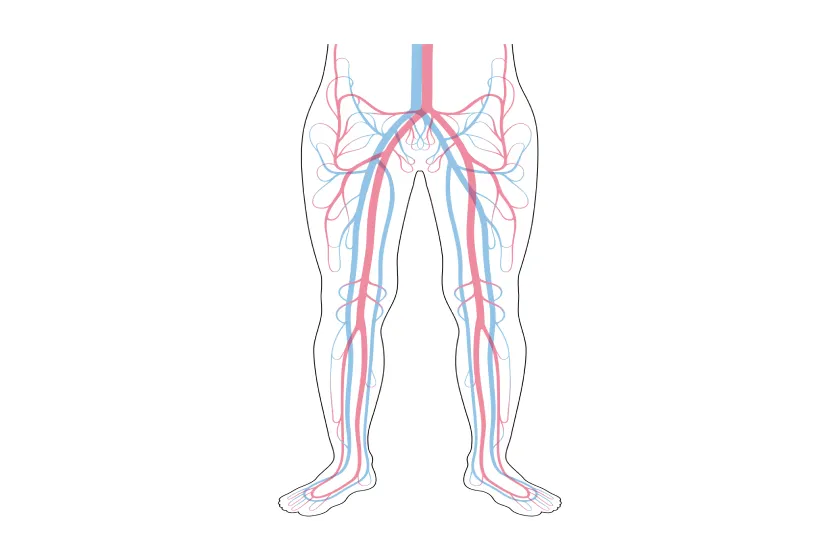
The Stages of Vein Disease and When to Act
Vein disease might begin as a seemingly harmless issue, like mild discomfort or visible veins, but left unchecked, it can lead to severe complications such as chronic pain, debilitating ulcers, or even life-threatening blood clots.
As a vascular surgeon, I’ve witnessed countless patients dismiss early signs only to seek treatment when complications arise. This blog aims to shed light on the stages of vein disease, why timely intervention is crucial, and how to prevent its progression.
Understanding Vein Disease
Vein disease, also known as chronic venous insufficiency (CVI), occurs when the veins in your legs struggle to efficiently return blood to the heart. Gravity makes this process challenging, but healthy vein valves ensure smooth blood flow. When these valves weaken or get damaged, blood pools in the legs, causing a cascade of symptoms.
Venous issues affect about 10-30% of adults in India, with women being slightly more prone than men due to hormonal and genetic factors. While lifestyle plays a significant role, hereditary predisposition cannot be overlooked.
Stages of Vein Disease
Vein disease doesn’t appear overnight; it progresses through distinct stages. Recognizing these stages can help you act before complications set in.
Stage 1: Spider Veins
Spider veins are tiny, dilated blood vessels visible under the skin, appearing as red, blue, or purple webs. They are often painless but may indicate underlying venous issues. Common causes of spider veins include prolonged standing, obesity, pregnancy, or hormonal fluctuations. While they’re frequently dismissed as cosmetic, they’re a warning sign of venous insufficiency.
Treatment:
- Lifestyle changes: Regular exercise and leg elevation can improve circulation.
- Spider vein treatment: Sclerotherapy or cosmetic surface laser therapy can eliminate these veins effectively.
Stage 2: Varicose Veins
Varicose veins are swollen, twisted veins that bulge under the skin. They’re more prominent and may cause discomfort, heaviness, or aching in the legs. Prolonged standing or sitting exacerbates symptoms.
When to act: If varicose veins cause pain, swelling, or itching, it’s time to consult a varicose vein doctor.
Treatment:
- Compression stockings
- Minimally invasive procedures like endovenous laser therapy (EVLT) or sclerotherapy
- Consultation with a vein specialist doctor near you
Stage 3: Swelling and Skin Changes
At this stage, venous insufficiency begins affecting the surrounding tissues. Symptoms include:
Persistent leg swelling
Skin discoloration or dark patches (hyperpigmentation)
Thickened, hardened skin (lipodermatosclerosis) in advanced stages
These changes occur due to chronic inflammation and inadequate blood flow. Treatment of varicose veins and skin discoloration becomes critical to prevent further complications.
Stage 4: Venous Ulcers
The most advanced stage, venous ulcers, are open sores that form due to poor circulation. They usually develop near the ankles and take weeks or months to heal. Untreated ulcers can lead to infections or other severe complications.
Treatment:
- Wound care and compression therapy
- Surgical intervention by a varicose veins surgeon
- Advanced therapies like skin grafting along with endovenous ablation
When to Act
Early intervention is the key to managing vein disease. Many patients delay treatment, assuming symptoms will resolve on their own. This delay increases the risk of complications such as blood clots (deep vein thrombosis), infections, and chronic pain.
Seek medical attention if you notice:
- Persistent leg swelling
- Increasing size of veins
- Pain or heaviness in the legs
- Skin changes or ulcers
- Discomfort interfering with daily activities
Remember, the earlier you act, the simpler and more effective the treatment.
Treatment Options for Vein Disease
Modern medicine offers numerous options for managing and treating vein disease:
Lifestyle Modifications: Regular exercise, weight management, and avoiding prolonged sitting or standing can significantly reduce symptoms.
Compression Therapy: Compression stockings improve blood flow and alleviate swelling.
Minimally Invasive Procedures:
- Sclerotherapy: Injecting a solution into veins to close them.
- Endovenous Laser Therapy (EVLT): Using laser energy to seal off damaged veins.
- Radiofrequency Ablation (RFA): Similar to EVLT but uses radiofrequency energy.
- Venaseal (Glue therapy): Uses special glue to seal the vein without any thermal energy
- Surgical Options: For advanced cases, procedures like vein stripping or ligation may be recommended.
Consulting a vein specialist doctor near you ensures personalized care tailored to your condition.
Preventing Vein Disease Progression
While some factors like genetics are beyond your control, adopting healthy habits can prevent or slow down the progression of vein disease:
- Stay Active: Incorporate walking or swimming into your routine.
- Elevate Your Legs: Resting with legs elevated reduces pooling.
- Wear Compression Stockings: Especially if you’re at risk due to occupation or lifestyle.
- Maintain a Healthy Weight: Reducing strain on your veins.
- Avoid Tight Clothing: Clothes that restrict blood flow can worsen symptoms.
Conclusion
Vein disease is not just a cosmetic issue; it’s a medical condition that requires attention and care. By recognizing the stages of vein disease and seeking timely intervention, you can avoid complications and improve your quality of life.
As a vascular surgeon, I encourage you to stay proactive about your vein health. If you’re experiencing any symptoms, consult a specialist without delay. Whether it’s addressing spider veins or managing venous ulcers, taking action today can save you from long-term challenges.
FAQ
Early symptoms include spider veins, leg heaviness, and mild swelling, often worsening after prolonged standing or sitting.
Spider veins are small, web-like, and usually painless. Varicose veins are larger, twisted, and often cause discomfort.
Swelling and discoloration occur due to chronic inflammation and poor blood flow in the advanced stages of vein disease.
Yes, venous ulcers are the most advanced stage of vein disease and require immediate medical attention.
Consult a doctor if you experience persistent swelling, skin changes, or pain in your legs, or if varicose veins interfere with daily life.
Treatment options include compression therapy, sclerotherapy, laser or radiofrequency ablation, and surgical interventions.
Yes, regular exercise, maintaining a healthy weight, and avoiding prolonged standing or sitting can prevent or slow the progression of vein disease.



